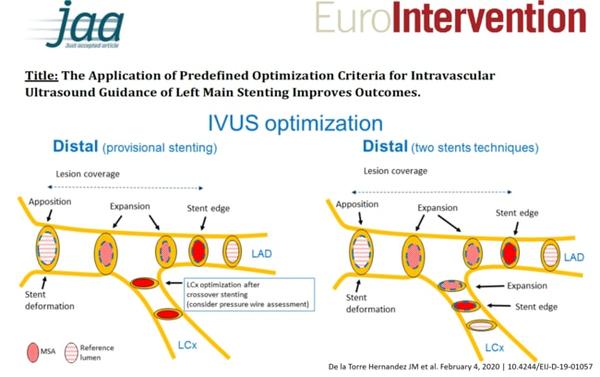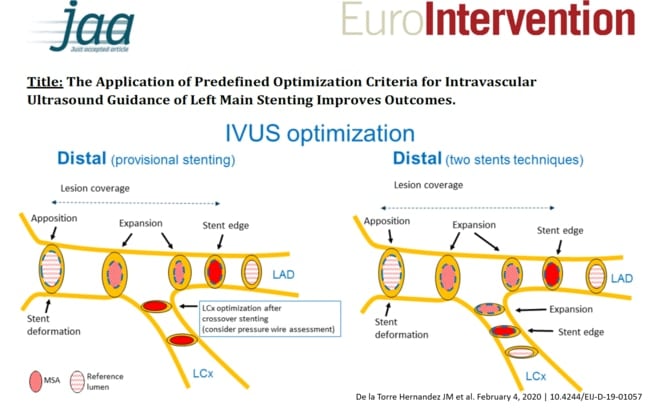The application of predefined optimisation criteria for intravascular ultrasound guidance of left main stenting improves outcomes
Selected in EuroIntervention by D. Milasinovic
This registry-based analysis evaluated the impact of standardisation of IVUS guidance on the results of LM PCI.
References
Authors
de la Torre Hernandez JM, Garcia Camarero T, Baz Alonso JA, Gómez-Hospital JA, Veiga Fernandez G, Lee Hwang DH, Sainz Laso F, Sánchez-Recalde Á, Perez de Prado A, Lozano I, Hernandez Hernandez F, Gonzalez Lizarbe S, Gutierrez Alonso L, Zueco J, Alfonso F.
Reference
EuroIntervention. 2020 Feb 4. pii: EIJ-D-19-01057. doi: 10.4244/EIJ-D-19-01057. [Epub ahead of print]
Published
February 2020
Link
Read the abstractReviewer
My Comment
Why this study? – the rationale/objective
Contemporary observational studies have indicated potential role of intracoronary imaging guidance in improving outcomes of left main (LM) percutaneous coronary intervention (PCI). This registry-based analysis evaluated the impact of standardization of IVUS guidance on the results of LM PCI.
How was it executed? – the methodology
Of the initial 1804 patients undergoing LM PCI, 3 groups of 124 patients each were propensity-matched (angio-only vs. IVUS vs. standardised IVUS).
Standardised IVUS-guided optimisation criteria included complete stent apposition, minimum stent area (MSA) >90% of the reference segment area, no proximal stent deformation, no dissection/hematoma or >40% plaque burden at stent edges.
Primary endpoint was the combination of cardiac death, LM-related myocardial infarction (MI) and target lesion revascularisation (TLR) in the left main at 12 months.
What is the main result?
The primary endpoint occurred in 4.8% of patients in the standardised IVUS arm, 8.0% in the non-standardised IVUS and 12.9% in the angiography-only arm (p<0.05 only for the comparison between standardised IVUS and angio-only).
All individual components of the primary endpoint tended to be reduced with the standardisation of the IVUS use, most evidently the repeated LM revascularisation (8% vs. 6.4% vs. 3.2%, p=0.09, for angio-guided, non-standard and standardised IVUS, respectively).
Whereas older age, diabetes and two-stent distal LM PCI independently increased the risk of subsequent events, standardised IVUS guidance was independently associated with the reduction in the primary endpoint (HR 0.45, 95%CI 0.15 – 0.98, p=0.04).
Critical reading and the relevance for clinical practice
The main message of this paper is that standardised IVUS guidance in left main PCI may improve clinical outcomes above and beyond both the angiography-only and non-standardised IVUS use.
In essence, the standardisation of IVUS use in this study led to more baseline IVUS being performed, which together with more meticulous post-stenting optimisation accounted for better stent expansion, more complete apposition and less plaque burden at the stent edges, as compared with non-standardised IVUS guidance.
Further to this main message, there seem to be at least the following 3 issues of interest regarding the practical application of IVUS-guided LM PCI.
- First, although, both standardised and non-standardised IVUS guidance resulted in stent expansion above previously published thresholds for post-PCI LM, ostial LAD and CX minimal stent area (MSA) of 8mm2, 6mm2 and 5mm2 respectively (Circulation: Cardiovascular Interventions. 2011;4:562–569), standardised IVUS was associated with larger absolute MSA values for all three segments, potentially highlighting the importance of reference segment-based approach for defining optimal stent expansion thresholds in LM PCI.
- Second, proximal stent deformation was detected in 5.6% of the cases performed with IVUS, which allowed for it to be corrected. These cases may have been missed on angiography.
- Third, even with the standardised IVUS protocol, 13% of patients still did not reach the prespecified criteria for optimal expansion, 5% did not achieve complete apposition and in 8% plaque burden was >40% at stent edges. This implies that more work may also be needed in the future in terms of improving our interventional tools and techniques to meet the challenges of heavy calcifications, large diameter left main and diffuse disease
In summary, this propensity-matched analysis offers new evidence that standardisation of intracoronary imaging guidance may further improve outcomes in patients undergoing left main PCI.

IVUS optimisation criteria






No comments yet!